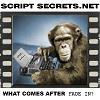PERSONAL
INJURIES
by William C. Martell
POP QUIZ. Which hurts more: hitting your elbow on a
door frame or getting blasted by a laser? The obvious answer is
the laser blast, but it isn't the correct answer. If I were to
show you a film clip where a man hit his elbow on a door frame,
you'd go "ouch". You'd understand the pain and empathize with the
man. But if I showed you a "Star Trek" clip where a laser
dissolves a man, it wouldn't effect you. You've never been hit by
a laser blast, you have no idea what it feels like.
We all know about the evils of abstracts. Mystery novelist
and TV writer Joe Gores says in the Mystery Writer's Handbook,
"Don't indulge in 'soft' writing. A street, means any street. A
car, means any car. I want to see a specific street, a specific
car. Hard detail is what makes a story believable."
You probably take special care when deciding whether your
protagonist drives a sports car or a family sedan, if he wears
tennis shoes or spats; but even specifics can be abstracts if the
audience hasn't experienced them personally.
Which takes us back to that laser gun. Even if you actually
know how lasers work, create a brand name and specifications,
fill in all the knobs and do-dads; the audience still won't feel
the pain along with your laser blastee.
George Lucas figured out a way to by-pass this problem by
creating 'light sabers', which are basically laser blades. They
cut. We all know what it is like to get cut, don't we?
Using action and violence in your script is meaningless
unless your audience can feel it. Remember: Film is
communication. Your script must be designed to communicate with
the audience (through the medium of the camera and the actors).
The difference between effective violence and gratuitous violence
is: Gratuitous violence isn't felt by the audience. It's just
exploitation. Spurting blood and exploding heads. Who among us
have had our heads explode? (If this HAS happened to you, please
don't write me... I'd rather not know).
So violence must be personalized.
Here are three examples of action scenes which work because
the audience understands the results of the violence:
Steven deSouza's "Die Hard" contains one of the most painful
moments on film. John McClane is our barefoot hero, taking on a
team of ruthless terrorists. Hans and Karl have cornered McClane
in the Computer Room, and the three are involved in a shoot out.
* * *
HANS
looks at the glass all around him, gets and idea. He SHOUTS to
Karl:
HANS
The glass! Shoot the glass!
And, saying this, he demonstrates. Karl follows suit.
McCLANE
As glass flies everywhere, McClane sees one option and takes it.
BLASTING a burst to keep their heads down, he WHIRLS, JUMPS on
top of a long counter and RUNS ACROSS THE ROOM. Their BULLETS
follow him, six inches behind his moving form.
McClane reaches the end of the counter, DIVES to the floor:
HIS FOOT
goes right down on a jagged SHARD. He groans, keeps going.
STAIRWELL DOOR
He's out, gone, safe.
INT. BATHROOM - NIGHT
McClane all but crawls inside. His dragging foot leaving a trail
of blood on the linoleum.
Wincing in pain, McClane washes his foot in a sink basin. He
washes a deep cut, but the pain doesn't relent.
* * *
When I was a kid, I was walking barefoot in my back yard and
stepped on a nail. It went right through my foot. I'll bet, in
your life, you once stepped on broken glass while barefoot. It
hurts. We know it hurts. When John McClane drags himself into the
bathroom, we know EXACTLY how he feels. The pain is real for us,
more real than a shotgun blast.
My second example is from the classic Dean Riesner scripted
"Play Misty For Me". Clint Eastwood is having a major ex-
girlfriend problem: She is trying to kill him. With a knife. A
very sharp knife. Do you know what 'defense wounds' are?
She attacks Clint with the knife, stabbing out at his face.
Not wanting to get stabbed in the face, he catches the knife in
his hand. Ouch! There's a close up shot of the blade slicing his
fingers as he tries to hang onto it. Double ouch! Then she pulls
the blade back, out of his hand, practically severing his
fingers. Triple ouch!
How many of us have been chopping an onion and cut
ourselves? Probably everyone. Again, we know EXACTLY how being
cut with a knife feels. When it happens on screen, part of the
audience's brain flashes back to the time THEY were cut, and they
instantly feel the pain.
My last example is from a dark comedy film called "Swimming
With Sharks" about a Personal Assistant who holds his mean
spirited Boss hostage and metes out a strange revenge for on the
job abuse. I've seen this film four times, and every time the
audience jumps at one painful scene. Even though I know the scene
is coming, it still affects me:
The Personal Assistant takes a crisp, clean, new piece of
paper and slashes his Boss's face with paper cuts. Ouch! He also
cuts his Boss's tongue with a sharp envelope flap. Ouch! This
scene was worse for me than "Play Misty For Me". I work with
paper and envelopes EVERY DAY. Paper cuts hurt worse than
anything else on earth (including that nail in the foot). And a
paper cut on your tongue? I've had one before. The pain stays for
weeks! If you haven't seen "Swimming With Sharks", it's well
worth a rent. Oh, and did I mention the Boss is a film producer?
The key to writing an effective action sequence is to make
sure the violence is something the audience understands, and can
empathize with. As B-Movie Maven Fred Olen Ray once asked me: "If
a man is shot by a laser and falls down, is the laser on stun or
kill? Is he hurt or dead?" We don't know, because we've never
been shot by a laser.
Personalizing action/violence/pain means showing us the
DETAILS. Details which we understand. Say you have a plane crash
survivor forced to search for help in a rocky terrain. He has
been walking all day, and stops to take off his dress shoes. When
he takes off his socks, we see the blisters on his feet. Big,
painful blisters. Some have broken open, and when the air touches
the nerve endings, our Survivor gasps in pain.
Anyone who has ever had new dress shoes knows how this
feels. Because this is drama, we have MAGNIFIED the injury and
the pain. Taken it up a couple of notches. Steven deSouza's
"Commando" ends with an epic battle in the furnace room of a
mansion. At one point, John Matrix's face is pressed against the
furnace door. Sizzle! We know how that feels, from the time we
lifted the pan without a pot holder. DeSouza has magnified the
pain by making the furnace door red hot, and subject of the burn
our hero's face. You know that's gotta hurt!
When you are writing a fight scene, think of the detail. The
personal injury which will make your audience gasp in
identification. I like to have villains break my hero's fingers,
either by crushing them or bending them backwards. We know that
hurts. Did you know that a pistol barrel gets hot after firing?
Hot enough to burn? When I have two characters struggling with a
gun which keeps discharging, I like to add in the burn factor.
Grab the barrel... sizzle... ouch! We may not have burned our
hands on a gun barrel, but we've burned our hands on SOMETHING.
We know exactly how it feels.
We know how it feels to have someone step on our foot really
hard, to get something in our eye, to get a pavement scrape, etc.
These are the kinds of things to use in your action scenes to
make them effective.
WHEN YOU WANT TO HURT THE WORLD
Your villain has spent his entire life hurting people one by
one, and now he's ready to move on to world destruction and/or
domination. He wants to blow up Cleveland or wipe out his
enemies' family lines. How do you make such massive destruction
personal? There are two ways to make big action effective on
screen.
ONE: Make sure your protagonist has a stake in the outcome,
and make sure the audience's identification with your protagonist
is VERY strong. A good example is Donald Stewart and W. Peter
Iliff's "Patriot Games". We are introduced to family man Harrison
Ford, his wife and daughter. We learn to care about them as a
family. When Ford steps in to thwart a terrorist bombing, not
only do the terrorist come after him, they come after his family
as well. Ford must stop the Terrorists, because he and his family
are directly threatened.
If your villain is killing a bunch of people you don't know,
or don't care about, it is meaningless violence. Giving a spear-
carrier a scene where he is kind to small animals before he is
killed just doesn't cut it. Audiences see it coming from a mile
away. Is there anyone in the world who saw "Top Gun" and didn't
KNOW Goose was about to die after they suddenly introduce his
wife and family halfway through the film?
TWO: Have the Villain's Plan threaten the audience. We are
sitting in the theater, minding our own business, when the
Villain threatens to unleash a virus which will spread like
wildfire. We see a map of the United States, and Donald
Sutherland shows us how far the virus will spread in 24 hours...
48 hours... 96 hours (entire map is covered). Now the audience is
affected by the villain's plan. If the hero doesn't stop him WE
will die.
This method works best in films like "Fail Safe" and "War
Games", where a nuclear incident will start a nuclear war which
will probably destroy the world. The audience itself is
threatened by the villain's actions. We will become the victims.
In my script "Crash Dive!", a group of terrorists have
hijacked a 688 Attack Class nuclear submarine, and are
threatening to nuke New York. Because I realized that might sound
like a good idea to some audience members, I added the threat of
firing at some random "small town" targets as well. Like the very
city where the movie theater you're watching "Crash Dive!" is
located in. Now you, the viewer, have a stake in the outcome.
The ultimate audience threat was in the William Castle film
"The Tingler". At the end of the film, the Tingler escapes into a
movie theater... the one YOU'RE sitting in! Vincent Price looks
RIGHT AT YOU and warns you "It's under your seat". Theaters were
wired with buzzers under some of the seats to reproduce the
feeling of the Tingler's attack. I'm sure a few people jumped.
THE ONE THING YOU DON'T WANT TO DO when creating violence in
an action scene is to make it ineffective and painless. If the
audience doesn't feel anything when a character is killed or
injured, that's akin to pornography. It's violence desensitized.
In Shane Black's "The Last BoyScout", one of our heroes gets
a knife stuck RIGHT THROUGH HIS HAND. He is pegged to a desk. He
pulls the knife out, wraps a handkerchief around the wound, and
is as good as new. This very violent act was without pain,
without feeling... desensitized.
In Shane Black's "The Long Kiss Goodnight", Henessey gets
beat up, shot a dozen times, blown out of an exploding building,
and manages to walk away unharmed. None of the violence in this
script has any effect on anyone. Getting blown out of a building
doesn't matter to Henessey, so why should it matter to the
audience? Getting shot doesn't matter. Getting hit doesn't
matter. When the bad guys kidnap Charly's daughter... it just
doesn't matter to us. If they shoot her, she'll just get up and
walk away, right?
Wrong. In real life pain hurts. Our job as screenwriters is
to make an emotional connection with our audience. To INVOLVE
them. To allow them to feel our characters' pain, and our
characters' joys. To do that, we must personalize our stories and
our action scenes and make the audience an active participant in
our script.
When you get ready to write the next draft of your script,
just remember: This time, it's PERSONAL.
FADE OUT
This is an excerpt from my book THE SECRETS OF ACTION SCREENWRITING, available below...
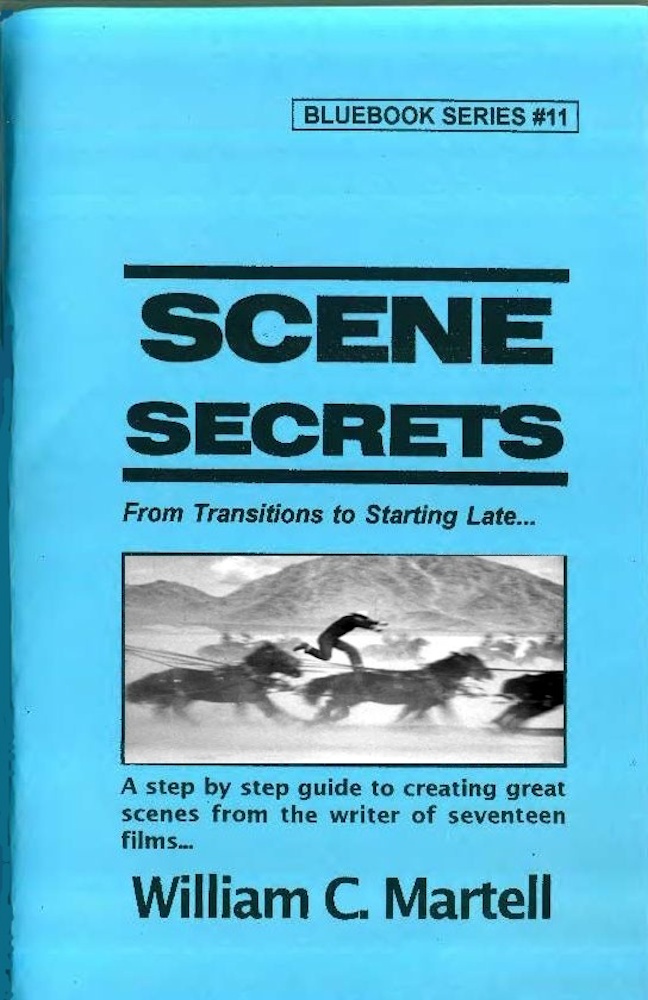
SECRETS OF SCENES!
*** SCENE SECRETS BLUE BOOK *** - For Kindle! (Exclusive)
What is a scene and how many you will need? The difference between scenes and sluglines. Put your scenes on trial for their lives! Using "Jaws" we'll look at beats within a scene. Scene DNA. Creating set pieces and high concept scenes. A famous director talks about creating memorable scenes.
12 ways to create new scenes. Creating unexpected scenes. Use dramatic tension to supercharge your scenes. Plants and payoffs in scenes. Plus transitions and buttons and the all important "flow"... and more! Over 65,000 words!
Print version was 48 pages, Kindle version is around 210 pages!
Only $3.99 - and no postage!
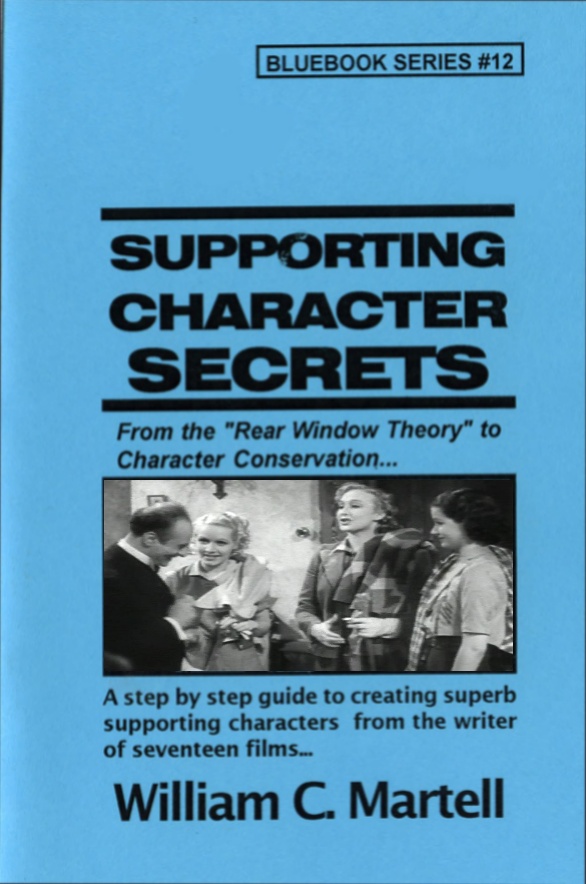
BEST SUPPORTING ACTORS?
*** SUPPORTING CHARACTER SECRETS *** - For Kindle! (Exclusive)
Expanded version with more techniques to flesh out your Supporting Characters and make them individuals. Using the hit movie BRIDESMAIDS as well as other comedies like THE HANGOVER and TED and HIGH FIDELITY and
40 YEAR OLD VIRGIN and many other examples we look at ways to make your Supporting Characters come alive on the page.
Print version was 48 pages, Kindle version is around 170 pages!
Only $3.99 - and no postage!
MY BLOG!
SCRIPT SECRETS STORE - Do you have a monkey mug yet?

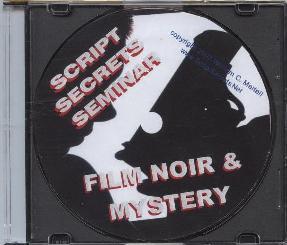
NEW CLASS!
NOIR & MYSTERY80 minute CD packed with information on writing Film Noir and Mystery scripts. Using examples from CHINATOWN to OUT OF THE PAST to DOUBLE INDEMNITY you'll learn how to create stories in this dark, twisted genre. How to plant clues, red herrings, suspects, victims, spider women, fallen heroes, the funhouse mirror world of noir supporting characters... and the origins of Film Noir in literature Noir dialogue and how noir endings are different than any other genre. All of the critical elements necessary to write in this critically popular genre.
The Noir & Mystery Class is only $15 (plus $5 S&H). First 20 on Limited Black Disk!
RECESSION SALE! $5 OFF!
IDEAS AND CREATIVITY - 80 minute CD packed with information. Tools to find ideas that are both personal *and* commercial. Hollywood wants scripts with High Concept stories... but not stupid scripts. Developing *intelligent* high concept ideas. How to turn your personal story into a blockbuster - or find your personal story in a high concept idea. Brainstorming and being creative. Ideas and Creativity is $10.00 (plus $5 S&H)
WRITING INDIES - Writing an Indie film? This class covers everything you need to know - from Central Locations to Confined Cameos. Using examples from SWINGERS, THE COOLER, STATION AGENT and others, this 80 minute CD is packed with information. How Indoe films challenge the audience (while mainstream films reassure the audience). Structures, using BOYS DON'T CRY, RUN LOLA RUN, HILARY & JACKIE, and others as example. Writing for a budget, writing for non-actors, getting the most production value out of your budget. Writing Indies is $10.00 (plus $5 S&H)
WRITING HORROR - The essentials of a horror screenplay - what do ROSEMARY'S BABY, NIGHT OF THE LIVING DEAD, THE EXORCIST, BRIDE OF FRANKENSTEIN, THE OTHERS and OPEN WATER have in common? This class will tell you! All of the critical elements necessary to write a script that scares the pants off the audience. Writing Horror is $10.00 (plus $5 S&H).
Click here for more information on CLASS CDs!
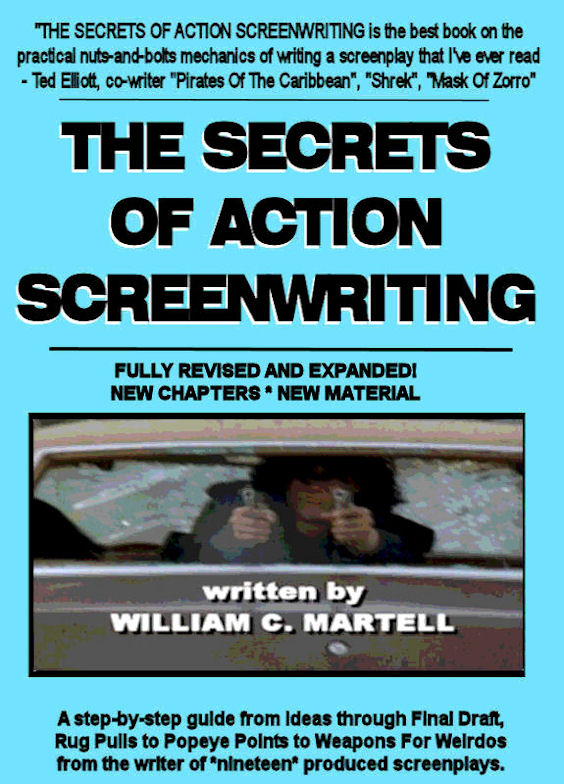
THE BOOK THAT STARTED IT ALL!
*** THE SECRETS OF ACTION SCREENWRITING *** - For Kindle!
*** THE SECRETS OF ACTION SCREENWRITING *** - For Nook!
Why pay $510 for a used version of the 240 page 2000 version that used to retail for $21.95? (check it out!) when
you can get the NEW EXPANDED VERSION - over 500 pages - for just $9.99? New chapters, New examples, New techniques!
"SECRETS OF ACTION SCREENWRITING is the
best book on the practical nuts-and-bolts mechanics of writing a screenplay I've ever read."
- Ted Elliott, co-writer of MASK OF ZORRO, SHREK, PIRATES OF THE CARIBBEAN and the sequels (with Terry Rossio). (ie; 4 of the top 20 Box Office Hits Of ALL TIME.)
Only $9.99 - and no postage!
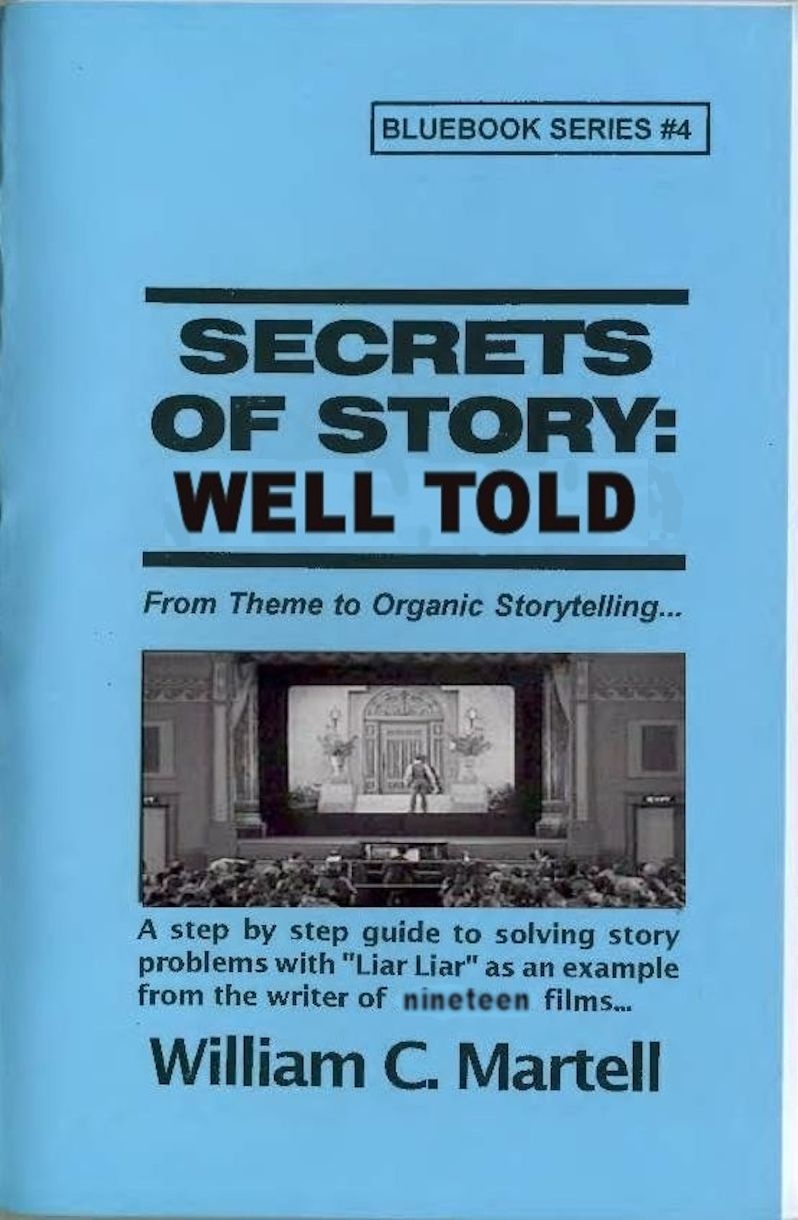
BRAND NEW!
*** STORY: WELL TOLD *** - For Kindle!
This book takes you step-by-step through the construction of a story... and how to tell a story well, why Story always starts with character... but ISN'T character, Breaking Your Story, Irony, Planting Information, Evolving Story, Leaving No Dramatic Stone Unturned, The Three Greek Unities, The Importance Of Stakes, The Thematic Method, and how to create personal stories with blockbuster potential. Ready to tell a story?
Print version was 48 pages, Kindle version is over 85,000 words - 251 pages!
Only $3.99 - and no postage!
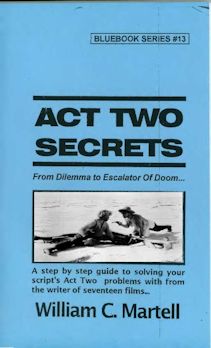
NEW: ACT TWO!
*** ACT TWO SECRETS *** - For Kindle!
Expanded version with more techniques to help you through the desert of Act Two! Subjects Include: What Is Act Two? Inside Moves, The 2 Ps: Purpose & Pacing, The 4Ds: Dilemma, Denial, Drama and Decision, Momentum, the Two Act Twos, Subplot Prisms, Deadlines, Drive, Levels Of Conflict, Escalation, When Act Two Begins and When Act Two Ends, Scene Order, Bite Sized Pieces, Common Act Two Issues, Plot Devices For Act Two, and dozens of others. Over 67,000 words (thatís well over 200 pages) of tools and techniques to get you through the desert of Act Two alive!
Print version was 48 pages, Kindle version is well over 200 pages!
Only $3.99 - and no postage!
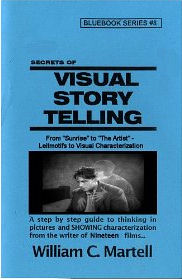
I WRITE PICTURES!
*** VISUAL STORYTELLING *** - For Kindle! (exclusive)
Show Don't Tell - but *how* do you do that? Here are techniques to tell stories visually! Using the first Oscar Winner SUNRISE and Oscar Nominee THE ARTIST plus other Oscar Winners as examples...
as well as RISE OF THE PLANET OF THE APES. Print version is 48 pages, Kindle version is around 250 pages!
Only $3.99 - and no postage!
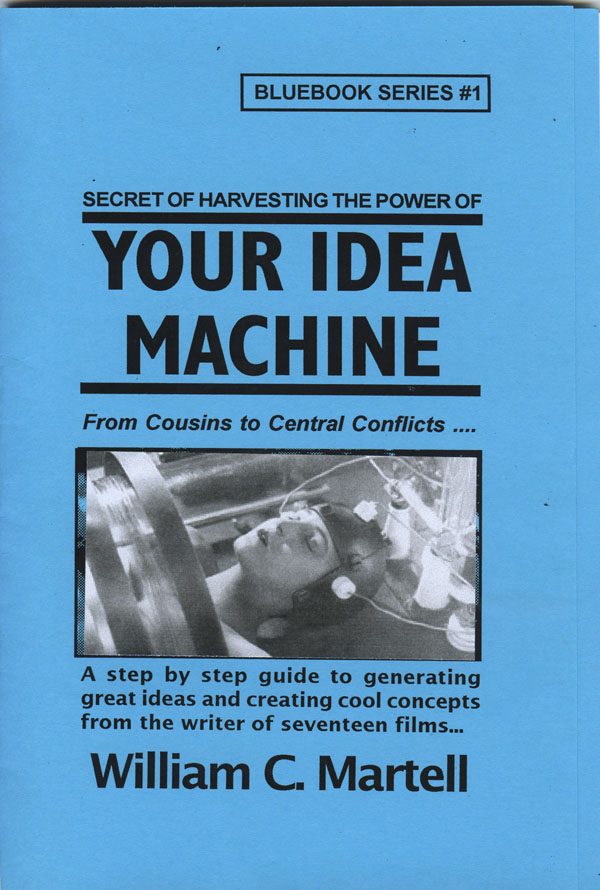
BEST SELLER!
*** YOUR IDEA MACHINE *** - For Kindle!
*** YOUR IDEA MACHINE *** - For Nook!
Expanded version with more ways to find great ideas! Print version is 48 pages, Kindle version is over 175 pages!
Only $3.99 - and no postage!
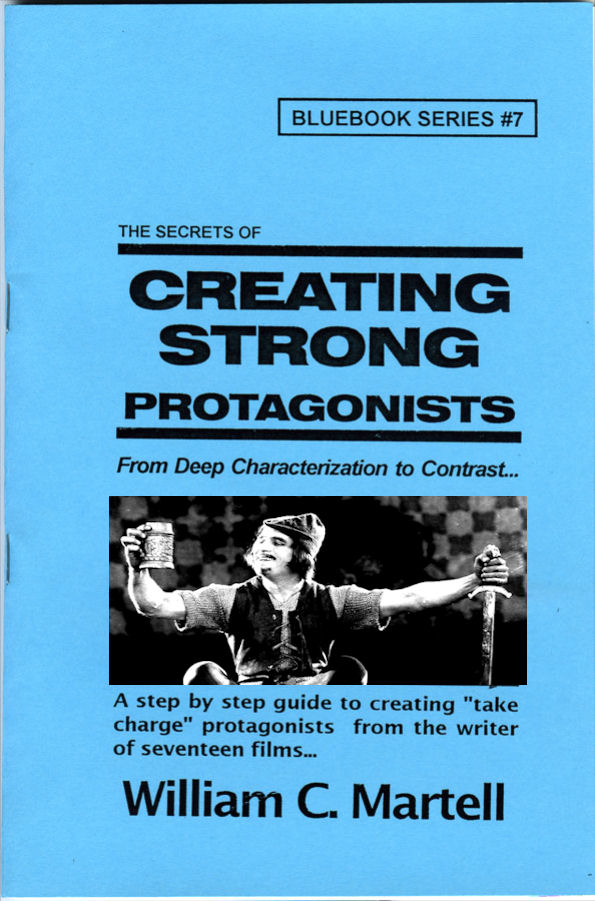
MOVIES ARE CHARACTERS!
*** CREATING STRONG PROTAGONISTS *** - For Kindle!
*** CREATING STRONG PROTAGONISTS *** - For Nook!
Expanded version with more ways to create interesting protagonists! Print version is 48 pages, Kindle version is once again around 205 pages!
Only $3.99 - and no postage!

HOT AND NEW!
*** DIALOGUE SECRETS *** - For Kindle!
*** DIALOGUE SECRETS *** - For Nook!
Expanded version with more ways to create interesting protagonists! Print version is 48 pages, Kindle version is almost 200 pages!
Only $3.99 - and no postage!

Use your creative energy to focus on the content; let Final Draft take care of the style. Final Draft is the number-one selling application specifically designed for writing movie scripts, television episodics and stage plays. Its ease-of-use and time-saving features have attracted writers for almost two decades positioning Final Draft as the Professional Screenwriters Choice. Final Draft power users include Academy, Emmy and BAFTA award winning writers like Oliver Stone, Tom Hanks, Alan Ball, J.J. Abrams, James Cameron and more.
* * * Buy It!
